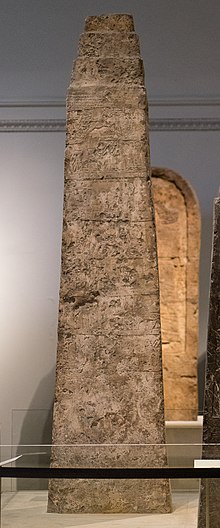| White Obelisk | |
|---|---|
 White Obelisk on display in the British Museum | |
| Material | Limestone |
| Size | Height 284 cm, Width 48 cm |
| Created | 1050-1031 BC |
| Discovered | Nineveh, Iraq |
| Present location | British Museum, London |
| Registration | ME 118807 |
The White Obelisk is a large stone monolith found at the ancient Assyrian settlement of Nineveh, northern Iraq. Excavated by the British archaeologist Hormuzd Rassam in 1853, it is one of only two intact obelisks to survive from the Assyrian empire, the other being the Black Obelisk of Shalmaneser III. Both are now preserved in the British Museum.[1] The White Obelisk dates to the beginning of the Neo-Assyrian Empire and has been variously ascribed to the reigns of Ashurnasirpal I (c. 1040 BC),[2] Tiglath-Pileser II (c. 950 BC)[3] or Ashurnasirpal II (c. 870 BC).[2]
- ^ "British Museum - The White Obelisk". Archived from the original on 2015-01-26. Retrieved 2020-11-07.
- ^ a b Reade 1975.
- ^ von Soden, W.F. (1975). "Zur Datierung des Weissen Obelisk". Zeitschrift für Assyriologie und Vorderasiatische Archäologie. 64 (2): 180–191. doi:10.1515/zava.1974.64.2.180. S2CID 161113642.